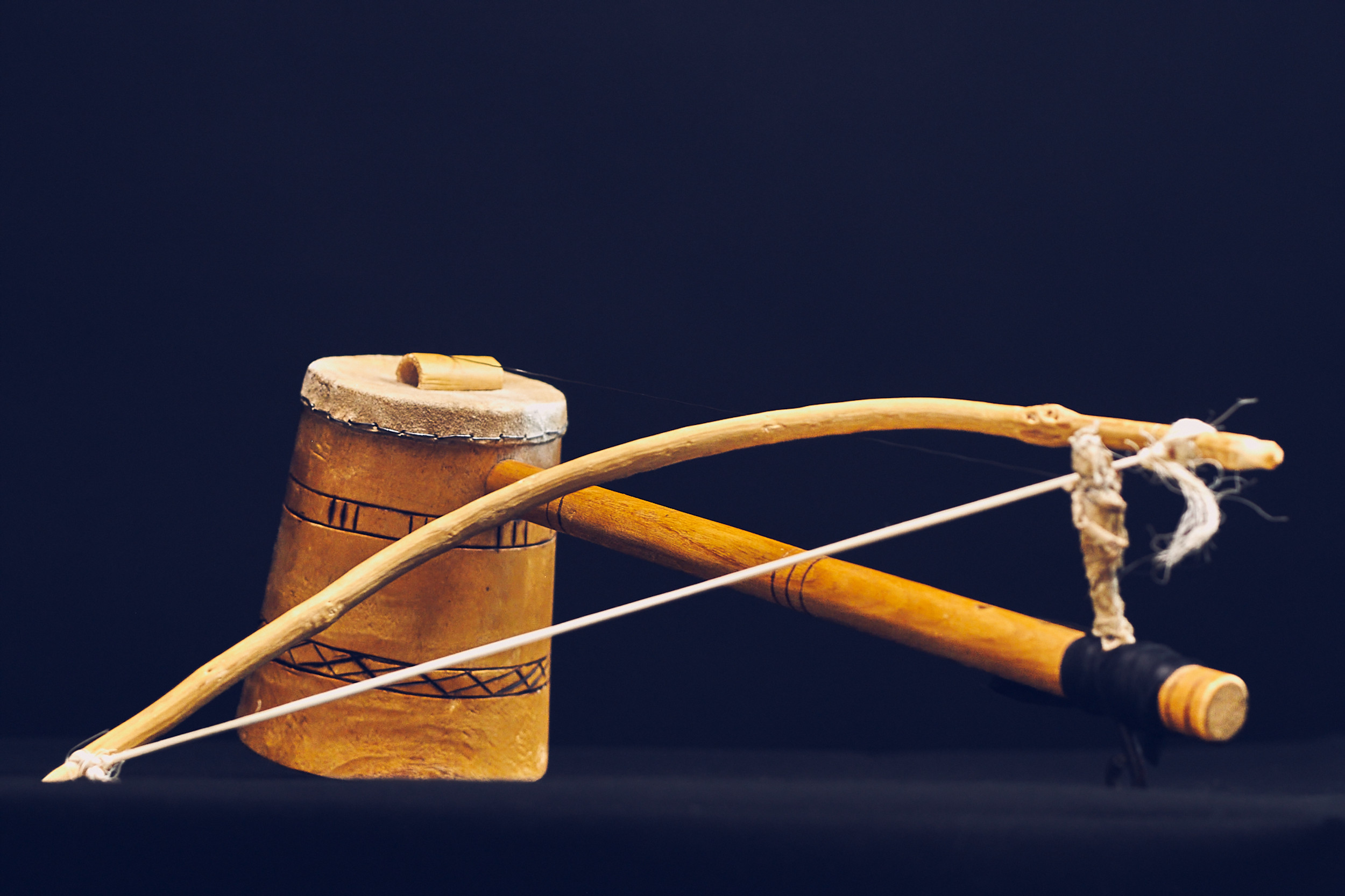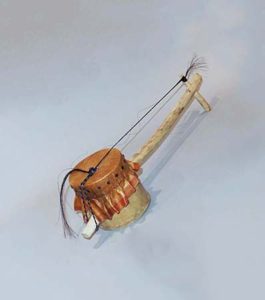Orutu
Bowed Instruments
Africa
Between 1001 and 1900 AD
Video
The Orutu, a remarkable musical instrument from East Africa, particularly the Luo community in western Kenya, is a symbol of rich cultural heritage and artistic expression. This one-stringed fiddle has a unique sound and history that reflects the traditions and evolution of music in the region.
What is the Orutu?
The Orutu is a traditional string instrument characterized by its vertical design and single string. It is often referred to as a fiddle and is played with a bow similar to that of a violin. The instrument consists of a cylindrical resonator made from hollowed wood, traditionally covered with monitor lizard skin on one side. The other side remains open, allowing for sound projection. The string was originally made from animal tendons or sisal fibers but has evolved over time to utilize materials such as bicycle brake cables for enhanced durability and sound quality. Musicians play the Orutu by drawing a bow across the string while simultaneously pressing down on the string with their fingers to create different notes. This technique allows for a range of sounds that can mimic human vocalizations, making it a powerful tool for storytelling and emotional expression in music.
History of the Orutu
The origins of the Orutu can be traced back to pre-colonial societies in East Africa, particularly among the Luo people of Kenya. Historical accounts suggest that this instrument has been in use for centuries, with roots deeply embedded in the cultural practices of the Luo community. The exact century of its inception remains unclear; however, it is believed to have developed alongside other traditional instruments during a time when music played an integral role in social gatherings, rituals, and storytelling. As colonialism swept through Africa in the late 19th and early 20th centuries, many traditional practices faced suppression. European missionaries often viewed indigenous music as incompatible with Christian teachings and sought to replace it with Western musical forms. This led to a decline in the popularity of instruments like the Orutu, relegating them to cultural artifacts rather than active components of musical life. Despite these challenges, the Orutu has survived and experienced a revival in recent years. Musicians and cultural enthusiasts are working tirelessly to preserve this unique instrument and its associated traditions. Today, it is celebrated not only for its historical significance but also for its contemporary relevance in African music.
How the Orutu Works
The working mechanism of the Orutu is relatively straightforward yet requires skill and precision from the player. The instrument’s structure includes:
- Resonator: The hollow wooden body serves as a sound chamber that amplifies the vibrations produced by the string.
- String: A single string is attached at one end of the resonator and extends over a bridge before being anchored at the other end.
- Bow: The bow is typically crafted from flexible wood or bamboo and strung with sisal fibers or other materials that allow for effective friction against the string.
- Tuning Mechanism: The tension of the string can be adjusted using various methods depending on construction techniques. Players often use their fingers to modify pitch while playing.
When played, musicians draw the bow across the string while applying pressure with their left hand fingers to create different notes. This method allows for expressive playing styles that can convey deep emotions through music.
Types of Orutu
While there are variations in design based on regional preferences and individual craftsmanship, most Orutus share common features that distinguish them from other instruments:
Traditional Orutu: Typically made using natural materials such as wood and animal skin, this version adheres closely to historical construction methods.
Modern Orutu: Contemporary variations may incorporate synthetic materials or repurposed items like bicycle cables for strings, reflecting modern innovations while retaining traditional aesthetics.
Orutu Variants: Some regions may have specific adaptations or names for similar instruments based on local dialects or cultural practices.
Each type serves similar functions within musical contexts but may differ in sound quality or playing techniques due to material choices or design alterations.
Features of the Orutu
The distinct characteristics of the Orutu contribute to its unique sound and cultural significance:
- Single String: Unlike many string instruments that feature multiple strings, the Orutu’s single-string design allows for focused melodic lines.
- Vertical Structure: The upright position facilitates ease of play while allowing musicians to engage physically with their performance.
- Resonant Sound: The hollow body enhances sound projection and resonance, producing tones that can be both hauntingly beautiful and deeply expressive.
- Cultural Symbolism: Beyond its musical capabilities, the Orutu represents cultural identity for many communities in Kenya.
These features make it an essential part of traditional music ensembles as well as solo performances.
Kind of Music Composed
The music created with the Orutu encompasses various genres but is most commonly associated with traditional Luo songs and contemporary benga music. Benga is characterized by its rhythmic guitar lines and upbeat tempos; however, when combined with the melancholic tones of the Orutu, it creates a unique fusion that resonates deeply with audiences.Orutu music often serves multiple purposes:
Storytelling: Many songs tell stories about love, loss, community events, or historical narratives.
Ceremonial Use: The instrument plays a significant role in rituals such as weddings or funerals where emotional expression is paramount.
Entertainment: Performances at social gatherings often feature lively tunes designed to engage audiences and encourage participation through dance.
Musicians frequently collaborate with vocalists and percussionists to create rich soundscapes that highlight both individual artistry and collective celebration.
Significance of the Orutu
The significance of the Orutu extends beyond its musicality; it embodies cultural heritage and identity within East African communities. As an instrument traditionally associated with male musicianship, recent efforts by female players challenge gender norms within this musical landscape. Women like Lorna Ochieng have emerged as prominent figures advocating for renewed interest in traditional instruments while breaking down barriers related to gender roles in music. Moreover, as globalization continues to influence African cultures, there is an increasing recognition of traditional instruments like the Orutu as vital components of national identity. Efforts to revive interest in these instruments are evident through educational programs aimed at teaching younger generations about their cultural roots.
In addition to preserving tradition, contemporary musicians are incorporating the Orutu into modern genres such as Afro-fusion or world music. This fusion not only keeps traditional sounds alive but also introduces them to new audiences worldwide.The revival movement surrounding instruments like the Orutu signifies a broader cultural renaissance taking place across Africa—a reconnection with heritage amid rapid modernization. As more artists embrace their roots through performance art forms like dance or theater combined with traditional instrumentation—there lies hope for sustaining these legacies into future generations.
FAQ
What material is the Orutu made of?
The Orutu is traditionally made from wood, with strings crafted from animal gut or modern synthetic materials. The bow often uses horsehair, and the resonator is a hollowed gourd covered with animal skin. These natural materials give the Orutu its distinct tone.
What type of music is played with the Orutu?
The Orutu is primarily used in traditional Luo music of Kenya, producing soulful melodies. It accompanies storytelling, celebrations, and dances, blending seamlessly with percussion and vocals. Its expressive sound suits both upbeat and melancholic themes.
What kind of instrument is the Orutu?
The Orutu is a single-stringed fiddle classified as a bowed string instrument. Played with a bow, it produces varied tones through finger pressure on the string. It is akin to a violin but with distinct African cultural significance.
 Links
Links
References
Other Instrument
Categories



















